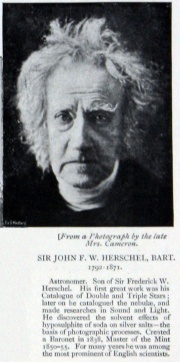John Frederick William Herschel
Sir John Frederick William Herschel (1792-1871), 1st Baronet Bart, KH, DCL, FRS, was an English mathematician, astronomer, chemist, and experimental photographer/inventor, who in some years also did valuable botanical work.
1792 March 7th. Born the son of the astronomer Frederick William Herschel and his wife Mary Baldwin
Father of 12 children.
Herschel originated the use of the Julian day system in astronomy. He named seven moons of Saturn and four moons of Uranus.
He made many contributions to the science of photography, and investigated colour blindness and the chemical power of ultraviolet rays. [1]
1871 May 11th. Died
1872 Obituary [2]
SIR JOHN FREDERICK WILLIAM HERSCHEL, Bart., K.H., D.C.L., F.R.S., &C., the only son of Sir William Herschel, the discoverer of the planet Uranus, was born at Slough on the 7th of March, 1792.
He received his early education privately, under a Scotch mathematician named Rogers, and subsequently entered St. John's College, Cambridge, where he took his B.A. degree in 1813, coming out as Senior Wrangler and first Smith's Prizeman.
In the same year he published his first work, 'A Collection of Examples of the Application of the Calculus to Finite Difference.'
In 1819 he commenced a series of Papers, in the "Edinburgh Philosophical Journal," on miscellaneous subjects in physical science ; and in 1822 communicated to the Royal Society of Edinburgh a Paper on the absorption of light by coloured media.
In 1816 he began to examine the double stars, in continuation of his father's work, Sir James South being united with him in the undertaking from March, 1821. The results appeared in six Memoirs, the last of which was published in 1836. His catalogue (made at Slough) of nebulae and clusters of stars is contained in the Philosophical Transactions of the Roya1 Society for 1833.
Early in 1834 he removed with his family and instruments to the Cape of Good Hope, where he remained for four years, for the purpose of observing and cataloguing the double stars and nebulae of the southern hemisphere. The results were published, in one volume, by the munificent aid of the Duke of Northumberland, in 1841, and his general catalogue of nebulae: appeared in the Transactions of the Royal Society for 1864.
0n his return from the Cape, in May, 1838, he was made a baronet ; and from December, 1850, to February, 1855, he occupied the post of Master of the Mint. The latter part of his lifetime was spent at Collingwood, near Hawkhurst, Kent, where he died on the 11th May, 1871.
One who knew him well writes that he was "an excellent workman, and his lathe-room adjoining his laboratory and his study was in constant use. . . . He made a working model of all his contrivances; and this as much from a determination to work up from the beginning of everything, and to meet and conquer every difficulty of construction himself, as from any mere love of manual work. . . . The system of the revolving roof on balls for his equatorial telescope was his own contrivance, and the whole building was made at Slough under his directions, and was capable of being taken to pieces and re-erected at the Cape. The ingenuity needed, and absolutely necessary, in contriving some support. for the heavy metal mirror of the 20-feet telescope, so that its figure should not be distorted, always excited our great admiration. . . . In such powers of contrivance, and in the mechanical knowledge which aided his ingenuity, no one would pretend that Sir John was pre-eminent, but that these should be found joined in the mind of the thoughtful philosopher, who threw hic; penetrating glance into every region of human speculation, lighting a beacon in advance here and there . . . ought to teach us, that the truly great mind is a well-balanced one. His private life and his study table were as garden ground to his roots, but his branches and his fruit he gave largely and ungrudgingly to the public; and the affectionate respect which greeted him wherever he went returned as light and air to his very heart, nourishing and increasing the wise and generous patriotism of his nature. . . there was nothing behind, to conceal or to reveal. Had it been in human nature to harmonise perfectly the aspirations and the actions of life, he would have done it - assuredly he attempted it.”
A more detailed account of Sir John Herschel’s life is given in the Proceedings of the Royal Astronomical Societies, and in the “Athenaeum ” and “Nature.”
It may suffice to add that he was elected an Honorary Member of the Institution of Civil Engineers on the 26th of June, 1838 ; and that in 1829 he married Margaret Brodie, daughter of the Rev. Dr. Alexander Stewart of Strathgarry, Perthshire, by whom he had a family of three sons and nine daughters.


